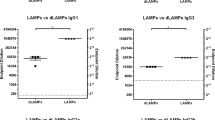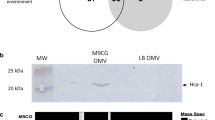Abstract
The Lyme disease vaccine is based on the outer-surface lipoprotein (OspA) of the pathogen Borrelia burgdorferi, and 95% of vaccine recipients develop substantial titers of antibodies against OspA. Here, we identified seven individuals with very low antibody titers after vaccination (low responders). The macrophages of low responders produced less tumor necrosis factor-α and interleukin-6 after OspA stimulation and had lower cell-surface expression of Toll-like receptor (TLR) 1 as compared to normal cells, but normal expression of TLR2. TLRs activate innate responses to pathogens, and TLR2 recognizes lipoproteins and peptidoglycan (PGN). After OspA immunization, mice genetically deficient in either TLR2 (TLR2−/−) or TLR1 (TLR1−/−) produced low titers of antibodies against OspA. Notably, macrophages from TLR2−/− mice were unresponsive to OspA and PGN, whereas those from TLR1−/− mice responded normally to PGN but not to OspA. These data indicate that TLR1 and TLR2 are required for lipoprotein recognition and that defects in the TLR1/2 signaling pathway may account for human hyporesponsiveness to OspA vaccination.
This is a preview of subscription content, access via your institution
Access options
Subscribe to this journal
Receive 12 print issues and online access
$209.00 per year
only $17.42 per issue
Buy this article
- Purchase on Springer Link
- Instant access to full article PDF
Prices may be subject to local taxes which are calculated during checkout






Similar content being viewed by others
References
Steere, A.C. Lyme disease. N. Engl. J. Med. 345, 115–125 (2001).
Shapiro, E.D. & Gerber, M.A. Lyme disease. Clin. Infect. Dis. 31, 533–542 (2000).
Barthold, S.W. Animal models for Lyme disease. Lab. Invest. 72, 127–130 (1995).
Seiler, K.P. & Weis, J.J. Immunity to Lyme disease: protection, pathology and persistence. Curr. Opin. Immunol. 8, 503–509 (1996).
Armstrong, A.L., Barthold, S.W., Persing, D.H. & Beck, D.S. Carditis in Lyme disease susceptible and resistant strains of laboratory mice infected with Borrelia burgdorferi. Am. J. Trop. Med. Hyg. 47, 249–258 (1992).
Barthold, S.W., de Souza, M.S., Janotka, J.L., Smith, A.L. & Persing, D.H. Chronic Lyme borreliosis in the laboratory mouse. Am. J. Pathol. 143, 959–971 (1993).
Barthold, S.W., Persing, D.H., Armstrong, A.L. & Peeples, R.A. Kinetics of Borrelia burgdorferi dissemination and evolution of disease after intradermal inoculation of mice. Am. J. Pathol. 139, 263–273 (1991).
Fikrig, E., Barthold, S.W., Kantor, F.S. & Flavell, R.A. Protection of mice against the Lyme disease agent by immunizing with recombinant OspA. Science 250, 553–556 (1990).
Schaible, U.E. et al. Monoclonal antibodies specific for the outer surface protein A (OspA) of Borrelia burgdorferi prevent Lyme borreliosis in severe combined immunodeficiency (scid) mice. Proc. Natl. Acad. Sci. USA 87, 3768–3772 (1990).
Telford, S.R. 3rd et al. Efficacy of human Lyme disease vaccine formulations in a mouse model. J. Infect. Dis. 171, 1368–1370 (1995).
Steere, A.C. et al. Vaccination against Lyme disease with recombinant Borrelia burgdorferi outer-surface lipoprotein A with adjuvant. N. Engl. J. Med. 339, 209–215 (1998).
Thanassi, W.T. & Schoen, R.T. The Lyme disease vaccine: conception, development, and implementation. Ann. Intern. Med. 132, 661–668 (2000).
de Silva, A.M. et al. Influence of outer surface protein A antibody on Borrelia burgdorferi within feeding ticks. Infect. Immun. 67, 30–35 (1999).
Medzhitov, R. & Janeway, C. Jr. Innate immune recognition: mechanisms and pathways. Immunol. Rev. 173, 89–97 (2000).
Takeda, K. & Akira, S. Roles of Toll-like receptors in innate immune responses. Genes Cells 6, 733–742 (2001).
Medzhitov, R. Toll-like receptors and innate immunity. Nature Rev. Immunol. 1, 135–145 (2001).
Imler, J.L. & Hoffmann, J.A. Toll receptors in innate immunity. Trends Cell Biol. 11, 304–311 (2001).
Akira, S., Takeda, K. & Kaisho, T. Toll-like receptors: critical proteins linking innate and acquired immunity. Nature Immunol. 2, 675–680 (2001).
Alexopoulou, L., Holt, A.C., Medzhitov, R. & Flavell, R.A. Recognition of double-stranded RNA and activation of NF-κB by Toll-like receptor 3. Nature 413, 732–738 (2001).
Poltorak, A. et al. Defective LPS signaling in C3H/HeJ and C57BL/10ScCr mice: mutations in Tlr4 gene. Science 282, 2085–2088 (1998).
Hoshino, K. et al. Cutting edge: Toll-like receptor 4 (TLR4)–deficient mice are hyporesponsive to lipopolysaccharide: evidence for TLR4 as the Lps gene product. J. Immunol. 162, 3749–3752 (1999).
Hayashi, F. et al. The innate immune response to bacterial flagellin is mediated by Toll-like receptor 5. Nature 410, 1099–1103 (2001).
Hemmi, H. et al. A Toll-like receptor recognizes bacterial DNA. Nature 408, 740–745 (2000).
Takeuchi, O. et al. Differential roles of TLR2 and TLR4 in recognition of gram-negative and gram-positive bacterial cell wall components. Immunity 11, 443–451 (1999).
Underhill, D.M., Ozinsky, A., Smith, K.D. & Aderem, A. Toll-like receptor-2 mediates mycobacteria-induced proinflammatory signaling in macrophages. Proc. Natl. Acad. Sci. USA 96, 14459–14463 (1999).
Brightbill, H.D. et al. Host defense mechanisms triggered by microbial lipoproteins through toll-like receptors. Science 285, 732–736 (1999).
Hirschfeld, M. et al. Cutting edge:inflammatory signaling by Borrelia burgdorferi lipoproteins is mediated by toll-like receptor 2. J. Immunol. 163, 2382–2386 (1999).
Takeuchi, O. et al. Discrimination of bacterial lipoproteins by Toll-like receptor 6. Int. Immunol. 13, 933–940 (2001).
Weis, J.J., Ma, Y. & Erdile, L.F. Biological activities of native and recombinant Borrelia burgdorferi outer surface protein A: dependence on lipid modification. Infect. Immun. 62, 4632–4636 (1994).
Erdile, L.F. & Guy, B. OspA lipoprotein of Borrelia burgdorferi is a mucosal immunogen and adjuvant. Vaccine 15, 988–996 (1997).
Fearon, D.T. & Locksley, R.M. The instructive role of innate immunity in the acquired immune response. Science 272, 50–53 (1996).
Schnare, M. et al. Toll-like receptors control activation of adaptive immune responses. Nature Immunol. 2, 947–950 (2001).
Erdile, L.F. et al. Role of attached lipid in immunogenicity of Borrelia burgdorferi OspA. Infect. Immun. 61, 81–90 (1993).
Ma, Y. et al. Outer surface lipoproteins of Borrelia burgdorferi stimulate nitric oxide production by the cytokine-inducible pathway. Infect. Immun. 62, 3663–3671 (1994).
Hajjar, A.M. et al. Cutting edge: functional interactions between toll-like receptor (TLR) 2 and TLR1 or TLR6 in response to phenol-soluble modulin. J. Immunol. 166, 15–19 (2001).
Ozinsky, A. et al. The repertoire for pattern recognition of pathogens by the innate immune system is defined by cooperation between toll-like receptors. Proc. Natl. Acad. Sci. USA 97, 13766–13771 (2000).
Kirschning, C.J., Wesche, H., Merrill Ayres, T. & Rothe, M. Human toll-like receptor 2 confers responsiveness to bacterial lipopolysaccharide. J. Exp. Med. 188, 2091–2097 (1998).
Modlin, R.L. Activation of toll-like receptors by microbial lipoproteins: role in host defense. J. Allergy Clin. Immunol. 108, 104S–106S (2001).
Fikrig, E. et al. Sera from patients with chronic Lyme disease protect mice from Lyme borreliosis. J. Infect. Dis. 169, 568–574 (1994).
Wooten, R.M. et al. Toll-like receptor 2 is required for innate, but not acquired, host defense to Borrelia burgdorferi. J. Immunol. 168, 348–355 (2002).
Thomas, V., Anguita, J., Barthold, S.W. & Fikrig, E. Coinfection with Borrelia burgdorferi and the agent of human granulocytic ehrlichiosis alters murine immune responses, pathogen burden, and severity of Lyme arthritis. Infect. Immun. 69, 3359–3371 (2001).
Pasparakis, M. & Kollias, G. in Cytokines: A Practical Approach (ed. Balkwill, F.R.) 297–328 (IRL Press, Oxford, 1995).
Acknowledgements
We thank T. Deshefy-Longhi, S. Samanta and D. Beck for assistance, and F. Manzo for assistance with manuscript preparation. This work was supported by grants from the US National Institutes of Health, and an Arthritis Foundation Biomedical Science Grant (RAF). L.A. received a Human Frontier Science Program postdoctoral long-term fellowship, E.F. received a Clinical-Scientist Award in Translational Research from the Burroughs Wellcome Fund, R.M. is supported by a Searl Scholarship, and R.M. is an Assistant Investigator and R.A.F. is an Investigator of the Howard Hughes Medical Institute.
Author information
Authors and Affiliations
Corresponding authors
Ethics declarations
Competing interests
E.F. and R.F. receive royalties from Yale University for a license agreement between Yale and SmithKline Beecham (GlaxoSmithKline) for an OspA-based vaccine.
Rights and permissions
About this article
Cite this article
Alexopoulou, L., Thomas, V., Schnare, M. et al. Hyporesponsiveness to vaccination with Borrelia burgdorferi OspA in humans and in TLR1- and TLR2-deficient mice. Nat Med 8, 878–884 (2002). https://doi.org/10.1038/nm732
Received:
Accepted:
Published:
Issue Date:
DOI: https://doi.org/10.1038/nm732
This article is cited by
-
A putative exosporium lipoprotein GBAA0190 of Bacillus anthracis as a potential anthrax vaccine candidate
BMC Immunology (2021)
-
Macrophage mediated recognition and clearance of Borrelia burgdorferi elicits MyD88-dependent and -independent phagosomal signals that contribute to phagocytosis and inflammation
BMC Immunology (2021)
-
Lyme arthritis: linking infection, inflammation and autoimmunity
Nature Reviews Rheumatology (2021)
-
Susceptibility to infection with Borrelia afzelii and TLR2 polymorphism in a wild reservoir host
Scientific Reports (2019)
-
Characterization of recombinant OspA in two different Borrelia vaccines with respect to immunological response and its relationship to functional parameters
BMC Veterinary Research (2018)



